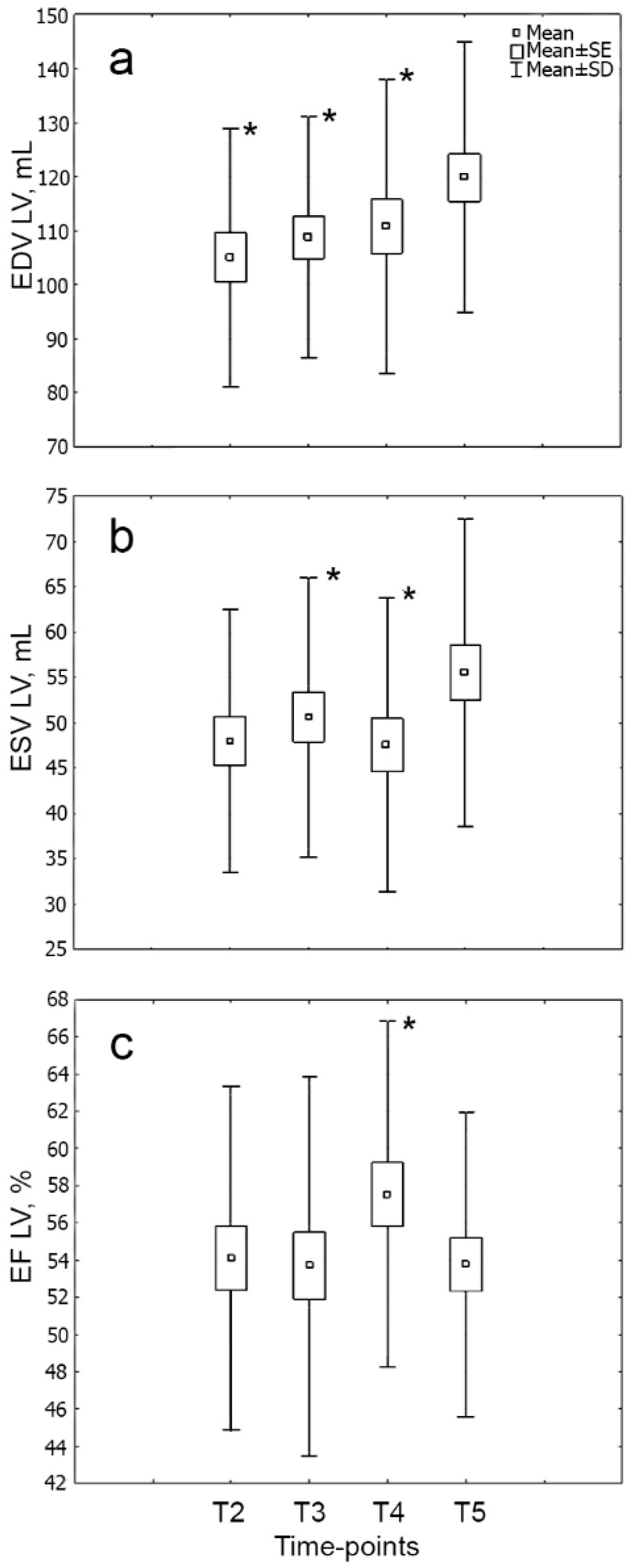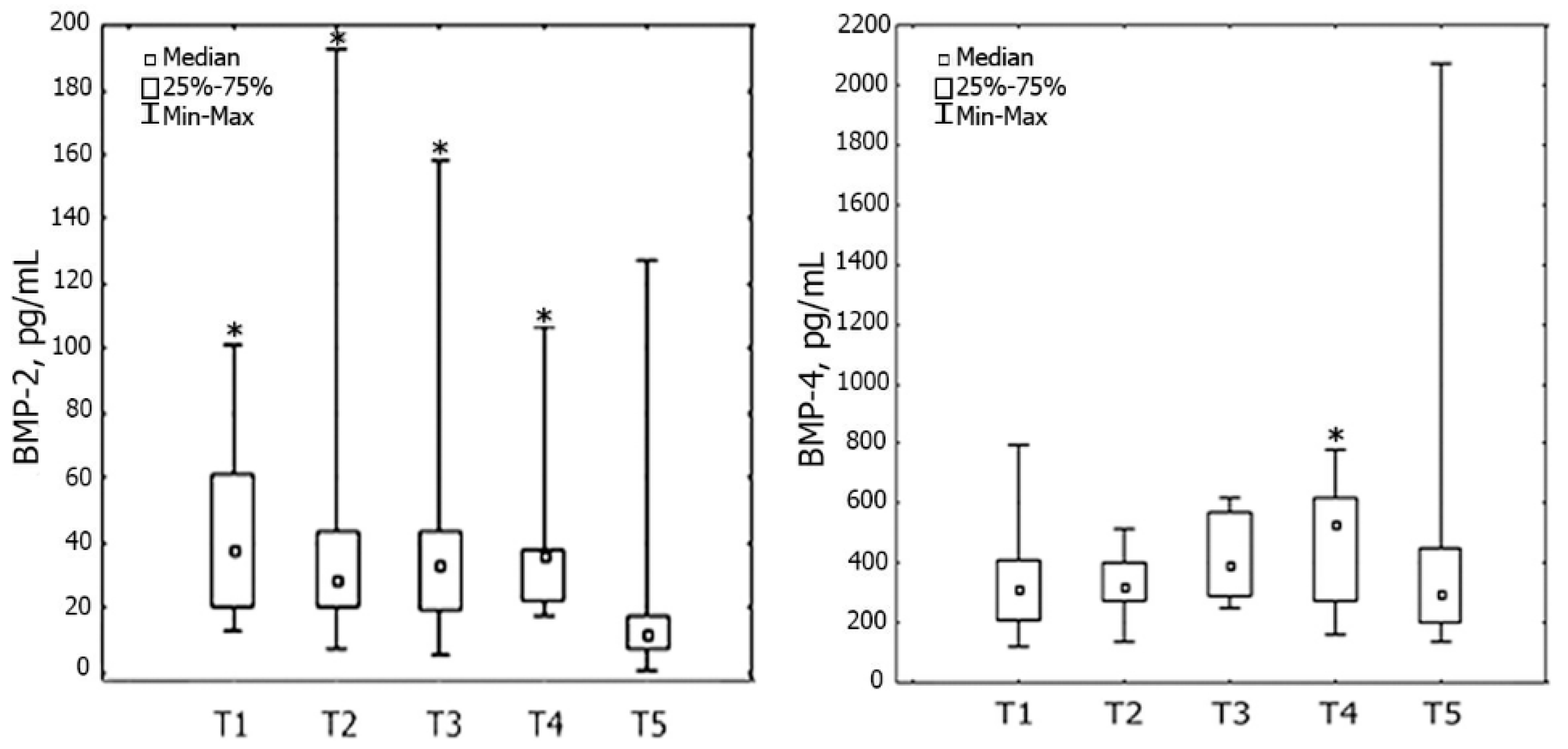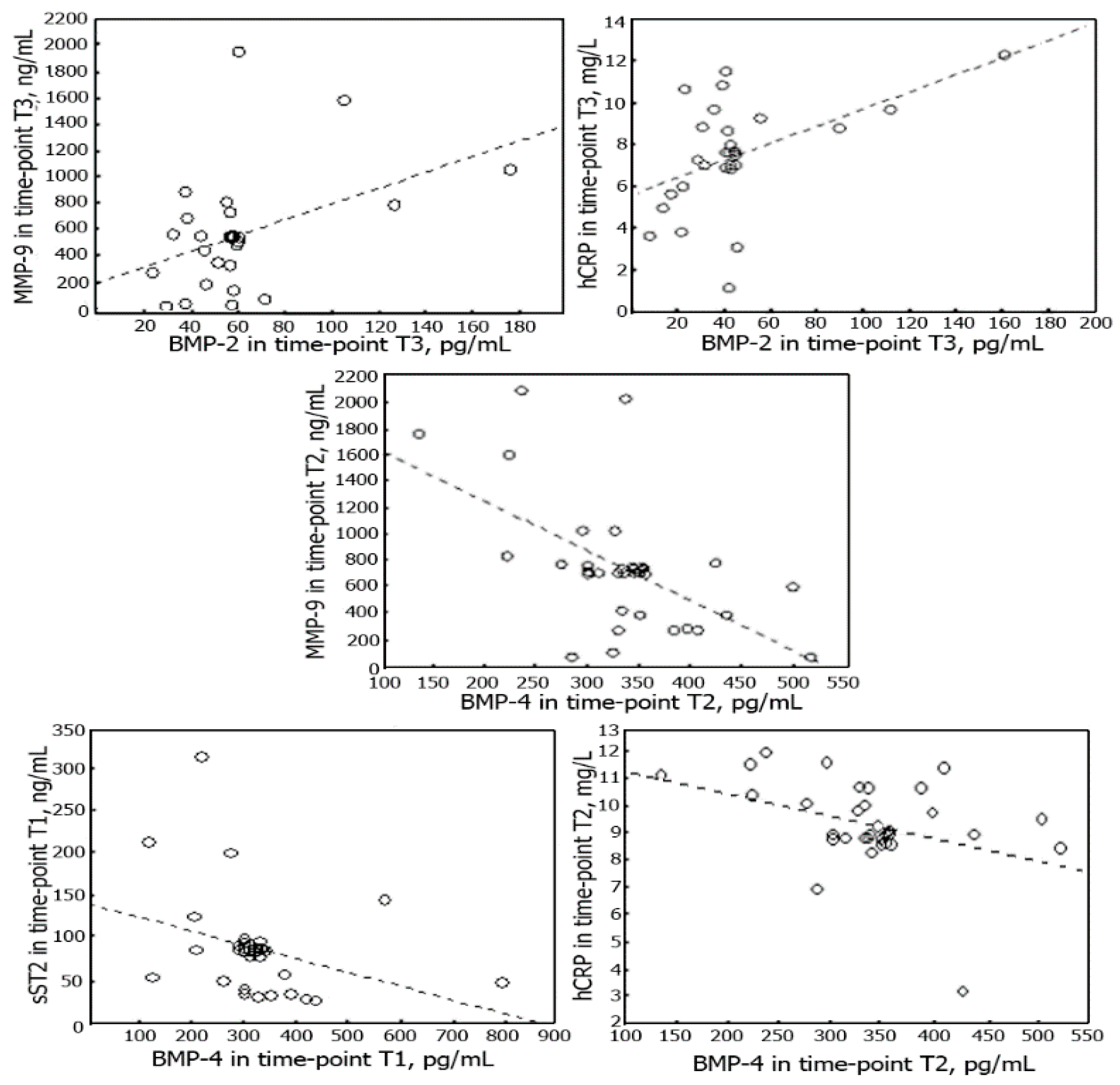Serum Levels of Bone Morphogenetic Proteins 2 and 4 in Patients with Acute Myocardial Infarction
Abstract
1. Introduction
2. Materials and Methods
2.1. Clinical Data Analysis
2.2. Assays
2.3. Data Analysis and Statistics
3. Results
3.1. Baseline Characteristics
3.2. Dynamics of BMP-2
3.3. Dynamics of BMP-4
3.4. Correlations between BMP-2 and BMP-4 and Serum Levels of hCRP, MMP-9, sST2 and NT-proBNP
3.5. Correlations between BMP-2 and BMP-4 and Adverse LVR in Both Early and Late Periods of AMI
4. Discussion
5. Conclusions
6. Limitations
Author Contributions
Funding
Acknowledgments
Conflicts of Interest
Abbreviations
| AMI | Acute myocardial infarction |
| BMI | Body mass index |
| BMP | Bone morphogenetic protein |
| CAD | Coronary artery disease |
| CHF | Chronic heart failure |
| ECG | Electrocardiogram |
| EDV | End-diastolic volume |
| EF | Ejection fraction |
| ESV | End-systolic volume |
| FC | Functional class |
| hCRP | High-sensitivity C-reactive protein |
| HF | Heart failure |
| LV | Left ventricular |
| LVR | Left ventricular remodeling |
| MMP | Matrix metalloproteinases |
| NT-proBNP | N-terminal pro-brain natriuretic peptide |
| PCI | Percutaneous coronary intervention |
| RFBR | Russian Foundation for Basic Research |
| sST2 | Soluble isoform of suppression of tumorigenicity 2 |
| STEMI | ST-segment elevation myocardial infarction |
References
- Cvjeticanin, B.; Prutki, M.; Dumic-Cule, I.; Veir, Z.; Grgurevic, L.; Vukicevic, S. Possible target for preventing fibrotic scar formation following acute myocardial infarction. Med. Hypotheses 2014, 83, 656–658. [Google Scholar] [CrossRef] [PubMed][Green Version]
- Ibanez, B.; James, S.; Agewall, S.; Antunes, M.J.; Bucciarelli-Ducci, C.; Bueno, H.; Caforio, A.; Crea, F.; Goudevenos, J.A.; Halvorsen, S.; et al. ESC Guidelines for the management of acute myocardial infarction in patients presenting with ST-segment elevation: The Task Force for the management of acute myocardial infarction in patients presenting with ST-segment elevation of the European Society of Cardiology (ESC). Eur. Heart J. 2018, 39, 119–177. [Google Scholar] [CrossRef] [PubMed]
- Ebelt, H.; Hillebrand, I.; Arlt, S.; Zhang, Y.; Kostin, S.; Neuhaus, H.; Müller-Werdan, U.; Schwarz, E.; Werdan, K.; Braun, T. Treatment with bone morphogenetic protein 2 limits infarct size after myocardial infarction in mice. Shock 2013, 39, 353–360. [Google Scholar] [CrossRef]
- Kercheva, M.; Ryabova, T.; Gusakova, A.; Suslova, T.E.; Ryabov, V.; Karpov, R.S. Serum Soluble ST2 and Adverse Left Ventricular Remodeling in Patients With ST-Segment Elevation Myocardial Infarction. Clin. Med. Insights Cardiol. 2019, 13, 1179546819842804. [Google Scholar] [CrossRef]
- Frangogiannis, N.G. The inflammatory response in myocardial injury, repair, and remodeling. Nature Rev. Cardiol. 2014, 11, 255–265. [Google Scholar] [CrossRef] [PubMed]
- Pallotta, I.; Sun, B.; Lallos, G.; Terrenoire, C.; Freytes, D.O. Contributions of bone morphogenetic proteins in cardiac repair cells in three-dimensional in vitro models and angiogenesis. J. Tissue Eng. Regen. Med. 2018, 12, 349–359. [Google Scholar] [CrossRef]
- Rutkovskiy, A.; Sagave, J.; Czibik, G.; Baysa, A.; Zihlavnikova, K.; Hillestad, V.; Peder Dahl, C.; Fiane, A.; Gullestad, L.; Gravning, J.; et al. Connective tissue growth factor and bone morphogenetic protein 2 are induced following myocardial ischemia in mice and humans. Scand. J. Clin. Lab. Investig. 2017, 77, 321–331. [Google Scholar] [CrossRef]
- Xiao, Y.T.; Xiang, L.X.; Shao, J.Z. Bone morphogenetic protein. Biochem. Biophys. Res. Commun. 2007, 362, 550–553. [Google Scholar] [CrossRef]
- Wu, M.; Chen, G.; Li, Y.P. TGF-β and BMP signaling in osteoblast, skeletal development, and bone formation, homeostasis and disease. Bone Res. 2016, 4, 16009. [Google Scholar] [CrossRef]
- McCulley, D.J.; Kang, J.O.; Martin, J.F.; Black, B.L. BMP4 is required in the anterior heart field and its derivatives for endocardial cushion remodeling, outflow tract septation, and semilunar valve development. Dev. Dyn. 2008, 237, 3200–3209. [Google Scholar] [CrossRef]
- Kercheva, M.; Ryabova, T.; Ryabov, V.; Karpov, R. Intraobserver reproducibility of parameters of standard and 2D speckle tracking echocardiography, dynamics of global longitudinal strain I in patients with acute primary anterior STEMI. AIP Conf. Proc. 2015, 1688, 030017. [Google Scholar]
- Voigt, J.U.; Pedrizzetti, G.; Lysyansky, P.; Marwick, T.H.; Houle, H.; Baumann, R.; Pedri, S.; Ito, Y.; Abe, Y.; Metz, S.; et al. Definitions for a common standard for 2D speckle tracking echocardiography: Consensus document of the EACVI/ASE/industry task force to standardize deformation imaging. J. Am. Soc. Echocardiogr. 2015, 28, 183–193. [Google Scholar] [CrossRef] [PubMed]
- Lang, R.M.; Badano, L.P.; Mor-Avi, V.; Afilalo, J.; Armstrong, A.; Ernande, L.; Flachskampf, F.A.; Foster, E.; Goldstein, S.A.; Kuznetsova, T.; et al. Recommendations for cardiac chamber quantification by echocardiography in adults: An update from the American Society of Echocardiography and the European Association of Cardiovascular Imaging. J. Am. Soc. Echocardiogr. 2015, 28, 1–39. [Google Scholar] [CrossRef]
- Zhang, M.; Sara, J.D.; Wang, F.L.; Liu, L.P.; Su, L.X.; Zhe, J.; Wu, X.; Liu, J. Increased plasma BMP-2 levels are associated with atherosclerosis burden and coronary calcification in type 2 diabetic patients. Cardiovasc. Diabetol. 2015, 14, 64. [Google Scholar] [CrossRef]
- Penn, M.; Mausner-Fainberg, K.; Golan, M.; Karni, A. High serum levels of BMP-2 correlate with BMP-4 and BMP-5 levels and induce reduced neuronal phenotype in patients with relapsing-remitting multiple sclerosis. J. Neuroimmunol. 2017, 310, 120–128. [Google Scholar] [CrossRef] [PubMed]
- Glanz, S. Primer of Biostatistics, 5th ed.; McGraw-Hill Education: London, UK, 2001; 454p. [Google Scholar]
- Pachori, A.S.; Custer, L.; Hansen, D.; Clapp, S.; Kemppa, E.; Klingensmith, J. Bone morphogenetic protein 4 mediates myocardial ischemic injury through JNK-dependent signaling pathway. J. Mol. Cell Cardiol. 2010, 48, 1255–1265. [Google Scholar] [CrossRef]
- Markov, V.A.; Ryabov, V.V.; Vyshlov, E.V.; Ryabova, T.R.; Shurupov, V.S.; Oyunarov, E.O.; Demyanov, S.V.; Maksimov, I.V. Postinfarction Heart Remodeling After Acute Myocardial Infarction and Pharmakoinvasive Reperfusion and Enhanced External Counterpulsation; STT: Tomsk, Russia, 2014; p. 244. [Google Scholar]
- Rymer, J.A.; Newby, L.K. Failure to Launch: Targeting Inflammation in Acute Coronary Syndromes. JACC Basic Translat. Sci. 2017, 2, 484–497. [Google Scholar] [CrossRef]
- Gombozhapova, A.; Rogovskaya, Y.; Shurupov, V.; Rebenkova, M.; Kzhyshkowska, J.; Popov, S.V.; Karpov, R.S.; Ryabov, V. Macrophage activation and polarization in post-infarction cardiac remodeling. J. Biomed. Sci. 2017, 24, 13. [Google Scholar] [CrossRef]
- Murray, P.J.; Wynn, T.A. Protective and pathogenic functions of macrophage subsets. Nature Rev. Immunol. 2011, 11, 723–737. [Google Scholar] [CrossRef]
- Snyder, R.J.; Lantis, J.; Kirsner, R.S.; Shah, V.; Molyneaux, M.; Carter, M.J. Macrophages: A review of their role in wound healing and their therapeutic use: Review of macrophages in wound healing. Wound Repair Regen. 2016, 24, 613–629. [Google Scholar] [CrossRef]
- Goichberg, P.; Chang, J.; Liao, R.; Leri, A. Cardiac stem cells: Biology and clinical applications. Antioxid. Redox. Signal. 2014, 21, 2002–2017. [Google Scholar] [CrossRef] [PubMed]
- Winnier, G.; Blessing, M.; Labosky, P.A.; Hogan, B.L. Bone morphogenetic protein-4 is required for mesoderm formation and patterning in the mouse. Genes Dev. 1995, 9, 2105–2116. [Google Scholar] [CrossRef]
- Sanders, L.N.; Schoenhard, J.A.; Saleh, M.A.; Mukherjee, A.; Ryzhov, S.; McMaster, W.J.; Nolan, K.; Gumina, R.J.; Thompson, T.B.; Magnuson, M.A.; et al. BMP Antagonist Gremlin 2 Limits Inflammation After Myocardial Infarction. Circ. Res. 2016, 119, 434–449. [Google Scholar] [CrossRef] [PubMed]
- Helbing, T.; Rothweiler, R.; Ketterer, E.; Goetz, L.; Heinke, J.; Grundmann, S.; Duerschmied, D.; Patterson, C.; Bode, C.; Moser, M. BMP activity controlled by BMPER regulates the proinflammatory phenotype of endothelium. Blood 2011, 118, 5040–5049. [Google Scholar] [CrossRef] [PubMed]
- Pardali, E.; Makowski, L.M.; Leffers, M.; Borgscheiper, A.; Waltenberger, J. BMP-2 induces human mononuclear cell chemotaxis and adhesion and modulates monocyte-to-macrophage differentiation. J. Cell Mol. Med. 2018, 22, 5429–5438. [Google Scholar] [CrossRef]
- Sorescu, G.P.; Song, H.; Tressel, S.L.; Hwang, J.; Dikalov, S.; Smith, D.A.; Boyd, N.L.; Platt, M.O.; Lassegue, B.; Griendling, K.K.; et al. Bone morphogenic protein 4 produced in endothelial cells by oscillatory shear stress induces monocyte adhesion by stimulating reactive oxygen species production from a nox1-based NADPH oxidase. Circ. Res. 2004, 95, 773–779. [Google Scholar] [CrossRef]
- Wong, W.T.; Tian, X.Y.; Chen, Y.; Leung, F.P.; Liu, L.; Lee, H.K.; Ng, C.F.; Xu, A.; Yao, X.; Vanhoutte, P.M.; et al. Bone morphogenic protein-4 impairs endothelial function through oxidative stress-dependent cyclooxygenase-2 upregulation: Implications on hypertension. Circ. Res. 2010, 107, 984–991. [Google Scholar] [CrossRef]
- Tian, X.Y.; Yung, L.H.; Wong, W.T.; Xiao, Y.T.; Lai, H.Y.; Wing, T.W.; Jian, L.; Fung, P.L.; Limei, L.; Yangchao, C.; et al. Bone morphogenic protein-4 induces endothelial cell apoptosis through oxidative stress-dependent p38MAPK and JNK pathway. J. Mol. Cell Cardiol. 2012, 52, 237–244. [Google Scholar] [CrossRef]
- Stahls, P.F.; Lightell, D.J.; Moss, S.C.; Goldman, C.K.; Woods, T.C. Elevated Serum Bone Morphogenetic Protein 4 in Patients with Chronic Kidney Disease and Coronary Artery Disease. J. Cardiovasc. Trans. Res. 2013, 6, 232–238. [Google Scholar] [CrossRef]



| At the Admission | |
|---|---|
| Parameters | |
| Male, n (%) | 21 (67) |
| Smoking history, n (%) | 15 (58) |
| BMI (kg/m2) | 28 ± 5.1 |
| Hypertension history, n (%) | 21 (67) |
| Diabetes mellitus, n (%) | 8 (25) |
| History of musculoskeletal disorders, such as osteoarthritis and osteochondrosis, n (%) | 5 (16) |
| Dyslipidemia, n (%) | 23 (74) |
| Killip class, n (%) | |
| 1 | 28 (91) |
| 2 | 1 (3) |
| 3 | 2 (6) |
| At the discharge | |
| Combined endpoint (death, recurrent MI, angina pectoris FC ≥ III, HF NYHA class > I), n (%) | 7 (22) |
| Recurrent MI, n (%) | 1 (3) |
| HF NYHA class > I, n (%) | 5 (16) |
| Angina pectoris FC ≥ III, n (%) | 1 (3) |
| Parameters | |
|---|---|
| Extent of CAD, n (%) | |
| 1-vessel CAD, n (%) | 22 (71) |
| 2-vessel CAD, n (%) | 7 (23) |
| 3-vessel CAD, n (%) | 2 (6) |
| Reperfusion time (hours) | 4.8 ± 3.3 |
| First 3 h, n (%) | 9 (29) |
| Thrombolysis + PCI, n (%) | 17 (54) |
| Primary PCI, n (%) | 14 (45) |
| Delayed PCI, n (%) | 14 (45) |
| Complete revascularization, n (%) | 20 (64) |
| LV EDV (Day 3), mL | 107 ± 21.9 |
| ΔLV EDV (Day 3, after 6 months),% | 13.0 ± 20.0 |
| LV ESV (Day 3), mL | 49 ± 15.1 |
| ΔLV ESV (Day 3, after 6 months),% | 19.6 ± 40 |
| LV EF (Day 3),% | 54.2 ± 9.2 |
| ΔLV EF (Day 3, after 6 months),% | 2.9 ± 7.6 |
| Variable | β (Standard Deviation) | T | p Value |
|---|---|---|---|
| Complete revascularization, n | 0.7 | 12.3 | 0.06 |
| Reperfusion time, h | 0.5 | 22.9 | 0.02 |
| BMP-4, pg/mL | 0.7 | 9.4 | 0.06 |
| BMP-2, pg/mL | 2.3 | 20.4 | 0.03 |
| Troponin I, ng/mL | 1.0 | 15.8 | 0.04 |
| hCRP, mg/L | 0.2 | 6.5 | 0.09 |
| sST2, ng/L | −2.5 | −22.2 | 0.02 |
| MMP-9, ng/mL | 0.6 | 10.7 | 0.06 |
© 2020 by the authors. Licensee MDPI, Basel, Switzerland. This article is an open access article distributed under the terms and conditions of the Creative Commons Attribution (CC BY) license (http://creativecommons.org/licenses/by/4.0/).
Share and Cite
Kercheva, M.; Gusakova, A.M.; Ryabova, T.R.; Suslova, T.E.; Kzhyshkowska, J.; Ryabov, V.V. Serum Levels of Bone Morphogenetic Proteins 2 and 4 in Patients with Acute Myocardial Infarction. Cells 2020, 9, 2179. https://doi.org/10.3390/cells9102179
Kercheva M, Gusakova AM, Ryabova TR, Suslova TE, Kzhyshkowska J, Ryabov VV. Serum Levels of Bone Morphogenetic Proteins 2 and 4 in Patients with Acute Myocardial Infarction. Cells. 2020; 9(10):2179. https://doi.org/10.3390/cells9102179
Chicago/Turabian StyleKercheva, Maria, Anna M. Gusakova, Tamara R. Ryabova, Tatiana E. Suslova, Julia Kzhyshkowska, and Vyacheslav V. Ryabov. 2020. "Serum Levels of Bone Morphogenetic Proteins 2 and 4 in Patients with Acute Myocardial Infarction" Cells 9, no. 10: 2179. https://doi.org/10.3390/cells9102179
APA StyleKercheva, M., Gusakova, A. M., Ryabova, T. R., Suslova, T. E., Kzhyshkowska, J., & Ryabov, V. V. (2020). Serum Levels of Bone Morphogenetic Proteins 2 and 4 in Patients with Acute Myocardial Infarction. Cells, 9(10), 2179. https://doi.org/10.3390/cells9102179







